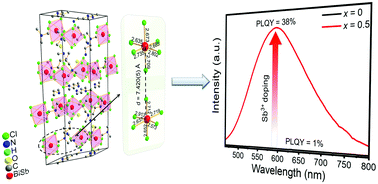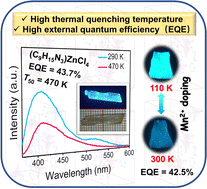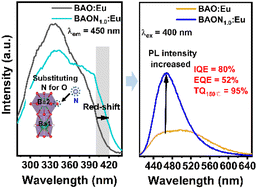Inorg. Chem. 2023, 62, 31, 12501–12509.https://doi.org/10.1021/acs.inorgchem.3c01726

Organic–inorganic metal halides (OIMHs) have various crystal structures and offer excellent semiconducting properties. Here, we report three novel OIMHs, (PPA)6InBr9 (PPA = [C6H5(CH2)3NH3]+), (PBA)2SbBr5, and (PBA)2SbI6 (PBA = [C6H5(CH2)4NH3]+), showing typical zero-dimensional (0D) structure, octahedra dimers, and corner-sharing one-dimensional chains and crystallized in the monoclinic system with P21, P21/c, and C2/c space groups, respectively. (PPA)6InBr9, (PBA)2SbBr5, and (PBA)2SbI6 have experimental optical band gaps of ∼3.16, ∼2.24, and 1.48 eV, respectively. (PPA)6InBr9 exhibits bright-orange light emission centered at 642 nm with a full-width at half-maximum of 179 nm (0.51 eV) and a Stokes shift of 277 nm (1.46 eV). After Sb3+ doping, the peak position did not change, and the photoluminescence quantum yield increased significantly from 9.2 to 53.0%. The efficient emission of Sb:(PPA)6InBr9 stems from the isolated ns2 luminescent center and strong electron–phonon coupling, making the spin-forbidden 3P1–1S0 observable. By combining commercial blue and green phosphors with orange-red-light-emitting (PPA)6In0.99Sb0.01Br9, a white-light-emitting diode was constructed, with the color-rendering index reaching up to 92.3. Our work highlights three novel 0D OIMHs, with chemical doping of Sb3+ shown to significantly enhance the luminescence properties, demonstrating their potential applications in solid-state lighting.







